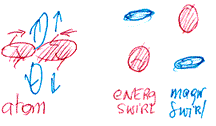Chapter 5 - Wave Theory and
the Electron
(Continued —
Page 3)
Printer-Friendly Version
Every electron has its own space, spin, momentum and mass
(interaction between energetic formations), and is a high-energy,
independent formation. As its  behaviour
is derived from the Schwarzschild swirl, so its rotation is
like the vertical, magnetic loop of a wave (see the chapter
on quarks). The electron’s polarity is negative; this
differs from the energetic swirl and path (picture right). behaviour
is derived from the Schwarzschild swirl, so its rotation is
like the vertical, magnetic loop of a wave (see the chapter
on quarks). The electron’s polarity is negative; this
differs from the energetic swirl and path (picture right).
In front of the magnetic swirl is a positron: a concentrated
swirl of energetic matter from the energetic swirl, having
a horizontal plane of rotation. When an electron (a swirl
with magnetic properties) collides with a positron, a high-energy
wave (photon) is formed (picture below).

In molecules, however, the connection between the positron
and the electron appears like a wave formation, and magnetic
energy from both atoms circulates as one magnetic swirl in
the molecule’s space.
Electricity is the movement of energetic matter in wires
around the surface of electrons (magnetic loops). The electrons
cannot handle the excess energy, and so the energy continues
to move onward. The electron is not a static object rotating
around a proton (energetic swirl), but a living formation,
constantly changing position and energy levels. As stated
by Feynman, orbit changes are very characteristic of electrons.
Energy loss in atoms occurs mainly through electrons (vibration).
The nucleus of the atom is composed of photon-like structures
strongly connected by their energetic loops (picture, near
right). The connection between atoms and  molecules
is the result of the electron (picture, far right): an energetic
condensate cloud in front of the energetic swirl, waiting
to be swallowed by it. The swirl slowly melts the matter until
a singularity is formed, which ejects the energy. The energy
becomes a magnetic loop that, in turn, creates another electron
cloud of condensate energetic matter. molecules
is the result of the electron (picture, far right): an energetic
condensate cloud in front of the energetic swirl, waiting
to be swallowed by it. The swirl slowly melts the matter until
a singularity is formed, which ejects the energy. The energy
becomes a magnetic loop that, in turn, creates another electron
cloud of condensate energetic matter.
Every addition of energy enlarges the cloud, but not the
swirl, which cannot exceed its original size. The electron
can thus come into contact with other swirls or jump orbits
(temporarily enlarge its space).
Disconnecting atoms and molecules occurs by adding energy
and enlarging the magnetic path connecting the electron. In
strong magnetic fields, one atom of a molecule travels to
the north pole of a magnet and a second travels to the south.
It is very important to understand molecular bonds. In the
first picture on this page, the A2 molecules travel to opposite
magnetic poles, demonstrating that they have different directions
of rotation.
Atoms in molecules rotate in opposite directions. The theoretical
structure of molecules is a very complex energetic matter
bond. The most important bonds between atoms and molecules
are by electrons, the most mobile formation in the atom. By
adding energy it can extend its space and easily come in contact
with a positron and create a wave formation (positron + electron
= electro-magnetic wave). The wave from two high-energy formations
is high-energy. It can be separated by adding energy or by
a lack of energy, as occurs in organic formations. A hydrogen
electron in organic bonds, with its large radius, is very
sensitive to downward energy shifts that decrease its size.
In the sodium atom, the second level photon is large and the
electron has a large radius that easily creates molecular
bounds.
In the atom, bonding is carried out by energetic loops. We
see clearly that their pulling forces maintain the structure,
while the pushing forces of magnetic loops weaken it. In molecules,
where bonding is by magnetic electron swirls, the structure
is weaker and needs more energy to maintain it . Distances
between atoms (waves) in a molecule are larger than between
photons (waves) in the atom’s nucleus; they can easily
be separated or joined.
Molecular bonds create energetic swirls between and around
atoms. In astronomical observations of celestial clusters,
we see similar formations that resemble beehives.
Energetic matters’ behaviour is the same in formations
of all sizes. Energy circulation in all objects must be executed
by wave formations. It is sometimes very difficult to find
a wave formation in an object, but by careful observation
we may do so.
Back to
Top
Dr. Chaim Tejman, Copyright©
2001. All rights reserved.
[Index]
[Introduction]
[Summary] [Wave
Formation] [Photons] [Gravitation]
[Time]
[Atoms] [Life]
[Cancer] [Fundamental
Force] [Gender/Why Sex?]
[Sexual Reproduction]
[Schrodinger & Heisenberg]
[Creation] [Supernova]
[Dark
Matter & Astronomy] [Speed
of Light] [Cloud Formations]
[Natural Disasters] [Global
Warming] [Thermodynamics]
[Backward Time] [Quantum
Mechanics] [Compton Effect]
[Equations] [Predictions]
[Academic Correspondences] [Contact]
[Links] [Mysteries] |